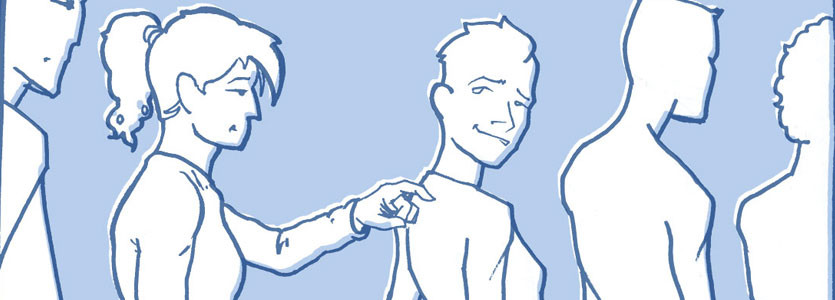
Okay, so the big day is here! You’re at the portfolio review! … Now what?
Before we get to the practical tips, we need to focus on a couple broader issues.
To date, most of the advice you’ve gotten about your art has come from a very small pool of teachers, family, and friends: people with a vested interest in you and your art. This review is likely the first time a knowledgeable stranger has given you their opinion and it’s going to be different. And, that’s kinda a great thing.
There’s a paradox to praise. A portfolio review may seem harsh but it can actually boost your opinion of your own art. Many of you have always been told you’re a good artist. Which, sure, is nice to hear. But, when it comes from your teachers, family, and friends, it can ring hollow. You think, maybe they’re just being nice or they’re just biased. But a portfolio reviewer? They’re an objective stranger with the expertise to back up their opinion. So, when they like your work, it’s pretty awesome.
The criticism can be brutal, and it can seem cruel. Try to remember, your reviewer doesn’t derive sustenance from the tears of aspiring artists. They’ve been exactly where you are now. They don’t want to hurt your feelings. They want to help you so that you’ll be sending out the best portfolio you can. If they’re too nice then you might not make the changes you have to. But they don’t want to be so harsh that you give up and don’t end up applying. You want them to be blunt and honest. But, you also want to remember that it’s just their opinion.
But, if you skipped all those big paragraphs, here’s a list of tips to get you through your portfolio review alive.
Get there early
Lines can be crazy long, like, ComiCon long. Portfolio Reviews usually run about four hours, start to finish. If you don’t want to spend the first hour standing in line you’re… well, gonna have to stand in line for an hour (or more) before the doors open. Soooo, bring a jacket?
Plan your Attack!
While you’re waiting in that line, figure out which schools you want to see the most. Map out where they are and how you’re going to get to them. Safest bet? Slog your way through the lines at the schools you really want to see first and then dash around to talk to as many reps who are free.
Dress comfortably
Lines are long and you’re going to be on your feet all day. I’ve seen kids in elaborate costumes, trying to wear their art cred on their sleeves. Don’t worry about it. You’re at a portfolio review; we know you’re an art nerd. Unless, you’re into apparel and you’re wearing a piece of your own design (in which case, look at you! Way to go! That’s totally novel and rad!) then just dress comfortably.
Mix it up
Don’t neglect the small schools. The advice you’ll get from these reps is just as good as the advice you’ll get from a larger school. The reps from the popular schools are going to get frazzled after talking for four hours straight. While the rep from a smaller school might still be on their first cup of coffee. Plus, without a long line, they can often spend more time talking to you about your art.
Take notes
Just like during your school critiques, you’re gonna want to write notes down while it’s going on rather than trying to drudge it all up from the depths of your memory days later when you finally sit down to fix your pieces. If you don’t want to do it in the middle of a review, that’s fine; it’ll give you something to do while you’re in the next line.
Ask questions, and have something to say
Yes, you’re there to get a rep’s expert opinion. But, if you feel like they’re not giving you enough feedback, ask them specific questions: “What’s my strongest work?” “What do I need to work on?” “What do you think of this specific piece?” “Should I put this one in my final portfolio?”
Contradictions
Art’s subjective. If you show your portfolio to five people you’re gonna get six opinions. It’s frustrating but… no, it’s just frustrating. All I can tell you is, after the review when you’re looking over your notes, try to find the common themes. What did most reviewers like? Which pieces did most of them think needed the most work?
Bring a book and a snack
Seriously, those lines are long.
Talk to the other students
Art students are a cowardly and superstitious lot… wait, no, that’s criminals in Gotham. Art students are kinda shy but really nice. Start up a conversation with the one in front of you. Chances are you’ll learn something.
Be prepared for what they might say
Look, I don’t want to tell you what you should and shouldn’t like to draw. But I can tell you some of the most common problems and complaints portfolio reviewers have with the art placed in front of them. But, if you’ve got a piece of art that hits a few of these points and it’s still a piece you’re proud of, put it in.
It needs work
A lot of pieces, even pieces you love, are only about 80% done. Don’t be discouraged if a reviewer calls you out on it and wants you to do a little work to finish a piece.
The white void
Got any pieces with a character or object just sorta floating there in the middle of a sea of white paper? Don’t. Get those pencils out and draw in a background. Lay down a shadow. Add some texture. Crop the image and play with the composition. This may seem like it falls under the first entry but it’s so prevalent it deserves it’s own entry.
Diversity
Art schools are usually impressed by students who work in a variety of media and depicting a variety of subject matter. Why? It gives them a better idea of your skill level and it implies that you’re flexible and willing to learn.
Color
My god, add color. The second most common complaint from portfolio reviewers is a lack of color. It’s totally understandable; color can be scary. But you’ve got to find a color medium you’re comfortable with. Digital applications like Photoshop and Painter can be great. If you’re working with traditional media, try watercolor or pastels. Start with a limited pallet of just a few colors that feel right together and add new colors when needed.
Celebrity portraits and copying photos
Copying from a photo is easy and it certainly feels great because it seems like you’re drawing looks better than your usual art, but it really doesn’t. It looks like it was copied from a photo. And we can tell. Every time. Copying makes your work tight, and worse, it doesn’t tell the reviewer anything about your ability. Now, some of you are thinking, “That’s the point!” But, art schools want to see what makes you unique. They want to see your strengths and your weaknesses. Not how well you copy. Please, trust me, a copied image will always be less impressive than one from observation or your imagination.
Anime bias
Most reviewers hate seeing anime in a portfolio. Put down your pitchfork! I’m not saying they don’t like anime. They probably have complete Studio Ghibli collection at home (just kidding; they absolutely do). But anime can be homogeneous, too much emphasis on drawing it ‘the right way’. And it’s often copied from existing pieces of art so… that checks off two boxes on this list. Oh, and if you read this entry and thought to yourself, “It’s manga, not anime.” Really? Don’t be that person.
So, that’s it! You are all set to hit the floor at your next portfolio review! Now all you have to worry about is actually applying to art school.


Leave a Reply